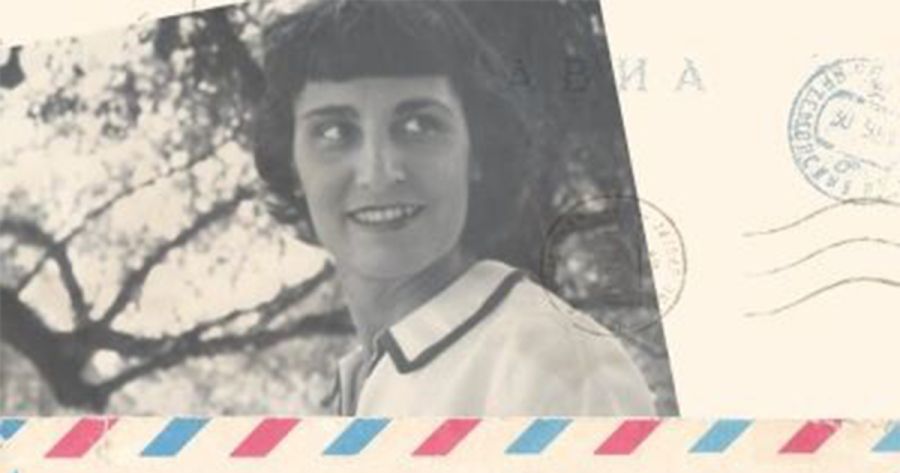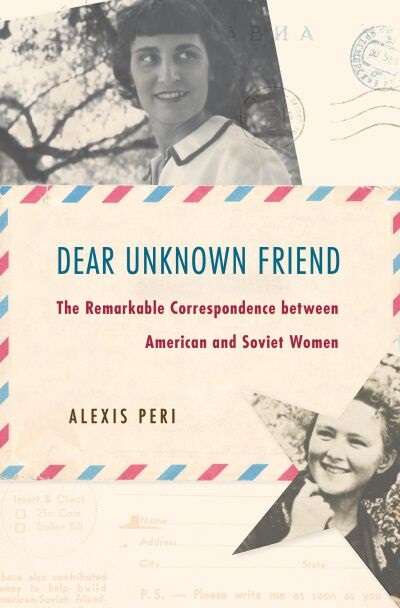
- Free Article: No
- Contents Category: History
- Review Article: Yes
- Article Title: You well understand
- Article Subtitle: A diplomacy of women and letters
- Online Only: No
- Custom Highlight Text:
When American Verena Koehler and Russian Zinaida Duvankova swapped recipes for Mexican-style beef and piroshki in the early 1950s, it didn’t seem that either were aiming to spark a political discussion. The pen pals were curious about each other’s food and lives, and the everyday differences between the United States and the Soviet Union. Yet they soon saw similarities. Koehler remarked on a woman’s need for simple, fast recipes when she both works and carries out domestic labour at home. Duvankova agreed – even as a Soviet state official, she completed a full day at work and returned home to all of the housework. As she wrote to Koehler, ‘You are a woman, and can well understand what it means to attend to a family of three.’
- Book 1 Title: Dear Unknown Friend
- Book 1 Subtitle: The remarkable correspondence between American and Soviet women
- Book 1 Biblio: Harvard University Press, US$35 hb, 304 pp
- Book 1 Cover Small (400 x 600):

- Book 1 Cover (800 x 1200):

Friendships like these sit at the heart of Alexis Peri’s Dear Unknown Friend. Duvankova worked at the Soviet Ministry of Grain Products. Koehler was an American department store clerk. They were perhaps ‘an unlikely match’, with their divergent educational and job status, as Peri observes. But the two women still had plenty to discuss, developing a bond over seventeen letters.
Soviet-American friendships during the mid-1940s and early 1950s might seem unlikely. In the decade following World War II, Joseph McCarthy’s brand of anti-communism raged, the transmission of information and people was limited, and, in the Soviet case, trans-border marriages were banned. And yet, between 1943 and 1953, more than 300 hundred pairs of Soviet and American women corresponded, writing affectionately to ‘dear unknown sisters’ and, with time, to cherished ‘aunts’ and ‘nieces’, with well-wishes and kisses.
The women were relatively ordinary: none were government officials, nor had experience in foreign policy. Many had never even visited another country. With the help of the Soviet Women’s Anti-Fascist Committee, established to develop aid relationships with the West during the war, and the leftist National Council of American-Soviet friendship, the two groups were put into ongoing contact. This was not without risk during the early years of the Cold War. Soviet women were careful with the personal details they put into print, in letters destined for the censor and then the West. And American women were, in some cases, put under FBI surveillance as a result of their activities. Nevertheless, they continued to write – and they were allowed to largely because they were women. Notes about recipes and childcare were small stuff, largely ignored by security services – despite any political content, or the pulling back of the Iron Curtain they may have represented, these were ‘just’ women.
Pen pals had become an American trend during the interwar period, while the phenomenon took longer to establish itself in the Soviet Union. No standard phrase for the practice even emerged in Russian until the mid-1950s, with drug po perepiske, meaning ‘friend by correspondence’. That said, Soviet citizens were well versed in letter writing, products of a long-standing culture of making personal petitions to state and Communist party leaders. Here, friendship provided the frame for citizen diplomacy. They shared parts of their lives over miles and oceans, aiming for connection and understanding, peace and propaganda. They discussed the personal and the political – and importantly, how they overlapped. A widow in California, operating a tractor during the war after her husband’s death, compared crops with a woman farming sugar beet in Kursk, in recently liberated Western Russia. A Missouri woman’s remark about her brother-in-law’s position in the army and his work at the Atomic Commission at Los Alamos was effectively ignored by its recipient in Moscow – an opportunity the KGB would have been sad to see slip away – while the two women engaged in a spirited conversation about why American teenagers had to work to fund their post-secondary education. Their opinions did not always align, but the pen pals dealt remarkably well with disagreement. The women consistently expressed themselves but were able to put aside difference, prioritising connection over ideology. Koehler, who swapped recipes with Duvankova, told her pen pal, ‘I like it when you get into your feelings … It does not bother me at all when we do not completely agree. I only get really angry at someone when he does not speak sincerely.’
Sincerity seems to have been the root of this crack in the Iron Curtain. The border was perhaps never as iron-clad as it might now seem – there were continual, if sporadic, moments of connection and exchange across the Cold War, from educational exchanges to travellers visiting with Intourist, a Soviet tour operator. Conventional wisdom indicates that until 1953, during Stalin’s lifetime, the Eastern Bloc remained off limits and that connection was neither sought nor achieved. Peri’s letter-writers suggest otherwise. These women did not assume that a Cold War – or war at all – was inevitable. They thought their differences were not irreconcilable and that dialogue provided a potential way forward.
What makes this East-West exchange unique was its sustained, deep engagement. Unlike the tourist visits or scientific exchanges, the letter-writers represented a larger cross-section of society. The Soviet women were labourers and farmers from across the Union during the war, while most writers in the postwar period were educated, professional Russians from Moscow. They were coached in what and how to write but they were not Communist party members – and did not always express the party line, as one might expect. The American council actually looked for conservative women who might participate, and they found them: writers on this side of the Atlantic were often middle class, Protestant women from the Midwest who voted Republican. As the 1950s wore on, more ‘progressive’ women from New England and California became involved.
Their correspondence was, of course, mediated and censored, though not as much as one might expect. Letters went through at least four sets of hands before they reached their recipient, but censorship was relatively light, often only removing remarks the censor thought might prove inadvertently insulting to the recipient. The writers were performing roles as citizens, women, workers, mothers, and peace advocates. They weren’t generally under pressure to be propagandistic mouthpieces, but they often promoted their own national way of life anyway. In their writing, these women wove themselves into national stories, pushing back on some elements but regularly promoting others.
Peri, an American historian, first found the letters in the Russian state archives: here were copies of the censored and uncensored, translated and untranslated correspondence. Then, Peri became a letter-writer in her own right. She dug deep into the histories of her subjects, contacting descendants and mining their memories and family archives. Here, she had more luck on the American side. She posted letters to Russia until March 2022, when the United States banned mail to Russia as part of sanctions related to the invasion of Ukraine. Those who did respond were reticent, avoidant, or politely declined Peri’s requests to talk. One of the more subtle revelations of Peri’s work is that communication between American and Russian citizens was more feasible and even perhaps welcome during the early Cold War than now.
These pen friendships probably did not influence international relations. But they do represent an alternative approach to diplomacy, to the intellectual analysis and fiery political rhetoric being deployed by powerful men at the time. These women thought that prioritising emotional openness, empathy, and vulnerability could be a political advantage, rather than a liability. Peri stops short of claiming that these connections changed the minds of the pen friends on either side, but she does ‘suspect it captured some hearts’. Her book has a lot of heart, too. Peri writes that ‘good conversations stay with us’ – even the conversations of others, recovered from dusty government files in state archives.


Comments powered by CComment